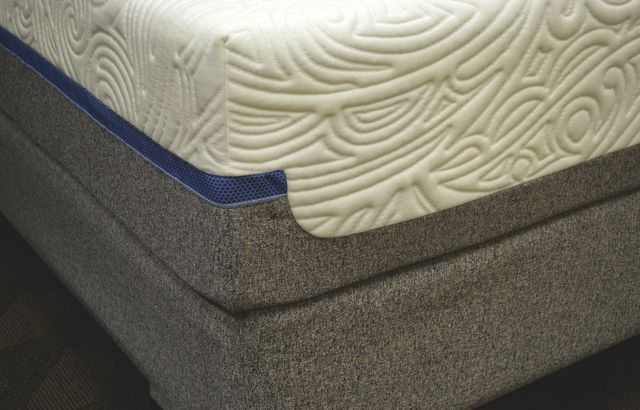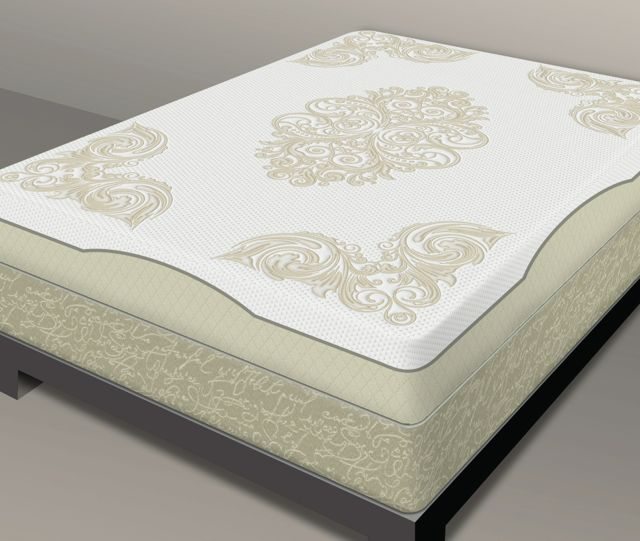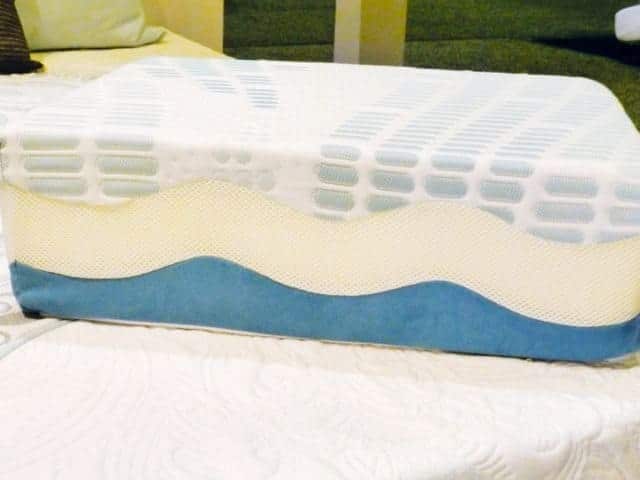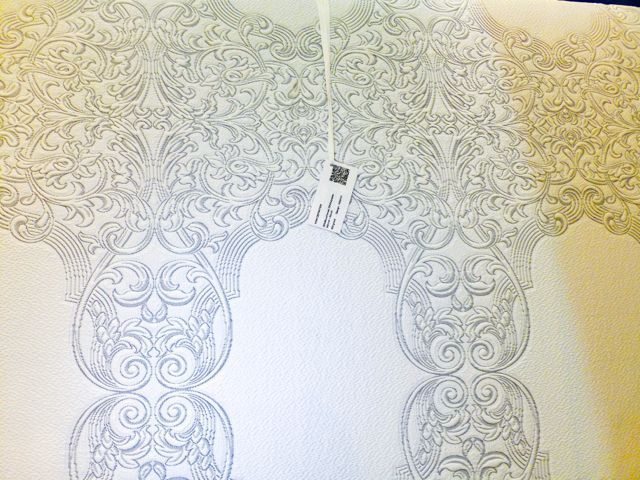Category makes a contemporary, sophisticated statement through enhanced sense of style
BY GARY JAMES
Fashion is playing an increasingly important role in today’s ticking as bed producers seek new ways to differentiate products on retail floors and grab consumer attention. Knit panels—the mattress industry’s most popular look—are getting more and more sophisticated thanks to the creation of more intricate knit designs that incorporate loft, texture and design motifs. The explosion in demand for these complex, three-dimensional stretch-knit fabrics is outstripping supply and keeping knitting machines running 24/7, suppliers say.

The Blues Bekaert Textiles’ Vivasio collection features an assortment of richly colored, textural border fabrics inspired by current home-furnishings fashions. Bekaert’s U.S. office is based in Winston-Salem, North Carolina.
While knits rule the roost in today’s marketplace, woven panels are getting more play of late, ticking producers say, especially at the upper end.
Bed borders are not to be ignored. They perform a starring role on today’s beds and grow bolder and more eye-catching by the day. The popularity of upholstery fabrics on the border is bringing an enhanced sense of fashion, creating a coordinated look that ties in with the latest trends in home furnishings.
Youthful, contemporary
At all price points, contemporary is becoming a buzzword in ticking, says Anne Bushell, design manager for Bekaert Textiles USA in Winston-Salem, North Carolina. “We’re being asked for more fresh, contemporary patterns. Transitional also is still important, but some of our customers want something a little edgier, so we’ve been exploring new directions to see what will work best.”
The industry is in a period “where design is more at the forefront compared to previous years,” says Önder Honi, vice general manager of Boyteks, a global source based in Kayseri, Turkey. “On beds, bases and borders, out-of-the-ordinary warp knits, velvets and heathers are being featured.” Winning looks for Boyteks include elegant wovens with natural fibers and knit fabrics “where colors and designs come forth across a wide variety of qualities.”

Chilling This cooling-enhanced, circular knit panel cascades to join Culp’s stylish upholstered base. The concept bed was designed by High Point, North Carolina-based Culp’s design team and sewn at its CLASS (Culp Lava Applied Sewn Solutions) facility.
Simmons’ Beautyrest Black line is a good example of where the market is heading, according to Bushell. “It features a very clean, diagonal geometric design with purposeful pops of black and fine channel work that makes a contemporary statement while still being classic.”
In knits, transitional styles that combine traditional values with a modern twist are where the action is, many ticking suppliers say. The interplay of panel and border is key.
“We’re keeping things more transitional, using very clean designs with just a touch of modern flair,” says Rose Fleming, design manager of CT Nassau in Alamance, North Carolina.

Crisp Montreal-based Maxime’s new line of blister fabrics features crisp colors and intricate patterns. The panels are accompanied by a wide range of knit borders, designed to match for a complete look.
Another hot trend in ticking, according to Stefan Hoffman, vice president of sales and marketing for Bekaert, is menswear-inspired design. “We’re using herringbone patterns and other subtle details to create a clean, tailored look. And it’s not just on the borders—we’re also bringing this influence into panels.”
The boldest ticking designs appear on zippered covers and covers for memory foam models, Hoffman adds. “Quilted traditional is still the main look for the innerspring segment.”
With traditional designs, medallions continue to be a popular motif, while florals seem to be fading. To update its medallions, CT Nassau has been using lighter touches of color rather than the big color blocks of the past. “We’re taking medallions to a new level with clean, saturated colors like purples and blues,” Fleming says. “It’s a fresh, tailored look.”

Customized This custom bed simulation was created by DesleeClama in Inman, South Carolina. It showcases an engineered queen-size top panel with baroque design elements, along with matching border and foundation fabrics.
Across all price points and market segments, panels are being upgraded in look, price, weight and features, says Craig Dunlop, president of DesleeClama North America, based in Inman, South Carolina. Large transitional patterns that are “interesting but elegant” are drawing attention, he says—“not too busy with large, unusual designs and intricate background effects and a touch of puff.”
And background textures in mattress ticking are being influenced by the geometric patterns seen in home decor, he adds.
Going forward, style preferences will continue to shift away from traditional “but not too fast,” says Sona von Hunke, a knit designer with Culp Home Fashions in High Point, North Carolina. “People are testing to see how modern they can go without becoming ‘cold.’ They are being very careful to keep the look accessible so that it doesn’t isolate the customer.”
At Culp, geometric patterns are doing well right now, as are watercolor-inspired designs.
“We’re constantly playing with new techniques to interpret watercolor prints as knits,” says Culp knit designer Adrienne Johnston. “Watercolors are very big on fashion runways, and they’re providing lots of inspiration for our business, too.”

All-in-one Part of Eden, North Carolina-based Innofa’s new Co-Creative Covers line, this model combines a traditional zoned medallion motif with a geometric border that are knitted as one piece. The cover also features blister accents and Innofa’s ThermoGel cooling treatment.
Techie details inspired by sportswear and athletic gear also are being used as subtle accents. “We’re taking modern shapes that everybody recognizes and creating little details with them,” Johnston says. “They help keep our fabrics current and relatable.”
These details also can highlight a fabric’s performance story, such as cooling or antimicrobial features, by conveying a sense of breathability or freshness.
Driven by home décor
Increasingly, ticking sources say, consumers are viewing mattresses as decorative pieces of furniture. As a result, they are gravitating toward mattress models with fashionable covers that fit in easily with other furnishings in the home.
“We keep in close touch with our upholstery group to see where their colors and patterns are going,” Johnston says. “Those directions have a big influence on what we do, particularly when it comes to borders and foundations. We can create looks that tie directly in with the latest upholstery trends.”
The use of upholstery looks for borders and foundations is clearly gaining steam. To serve this market segment, Lava Textiles, headquartered in Waterloo, South Carolina, recently forged a collaboration with a U.S. upholstery fabric mill that expands its border options.
“We have been offering mostly knit borders, but some customers prefer wovens, so this provides a range of new choices,” says Ann Weaver, vice president.
Ensemble styling
Coordination across a line has become a key element of brand strategies, says Dennis St. Louis, vice president of business development and national accounts for Creative Ticking in Gastonia, North Carolina. “Producers want the color palette to flow from price point to price point. That wasn’t the case a few years ago. Now, we’re developing models that tell a complete story, from $499 on up to $1,500 and higher. The borders and foundation colors and patterns are often consistent, with the panel design varying from model to model.”

Connected Developed in Italy, CT Nassau’s all-in-one Fascia line features a stylish range of woven jacquard patterns in luxurious constructions and vibrant colors. CT Nassau is headquartered in Alamance, North Carolina.
Producers seek cover combinations that both coordinate and contrast so that individual models stand out while also telling a clear brand story, says Jorge Sifuentes, sales manager of Enriquez Materials and Quilting in Commerce, California. “Everything needs to go together, like an elegant outfit. The panel is the suit, the border is the shirt and the tape is the tie. They each need to create interest while also working in harmony.”
Taking a cue from fashion, Bekaert uses tapes and borders to add character to its designs. “In men’s shirts, you’ll often see a touch of color or pattern around the neckline or the cuffs,” Hoffman says. “Similarly, with our designs, we try to weave in an interesting accent color or pattern that adds ‘pop.’ It’s a complement to the total package—a bit of punctuation without being ‘in your face.’ ”
‘Glammed out’ borders
While panel fabrics remain a focal point in mattress design, borders continue to grow in importance as a key platform for attracting consumer attention at retail.
“There’s always been a philosophy that the panel sold the bed,” says Hope Huston, director of marketing and design for Creative Ticking. “Now, while the panel’s still important, the real creative energy is applied to the borders, which have become much more elaborate. Beds have truly become a fashion-forward product on a par with other furnishings in the home, and border design is a big part of that.”
“When single-sided bedding first came out, everybody was instantly trying to save money on borders,” Bekaert’s Hoffman says. “But we’re all remembering now that when consumers walk into the mattress store, the border is what grabs their attention.”
When it comes to today’s border designs, there are “two distinct camps” in the market, CT Nassau’s Fleming says. “One group wants the border to really pop with bold, bright color; the other wants something more understated and traditional that fades into the panel.”

Wavy Recent additions to MFI International’s cut-and-sew line include this stretch knit cut-and-sewn cover with a wave-like border treatment. MFI is based in El Paso, Texas.
On its transitional and contemporary designs, CT Nassau is “going wider and bolder with borders and doing some exciting new things with tapes, stitches, colors and yarns,” Fleming says.
Particularly on higher-end products, deeply saturated colors such as darker grays and earth tones are gaining steam for borders, Hoffman says. In addition, multiple colors and materials are being mixed to create lively patterns and contrast.
A walk down the color runway
In panels, fabric designers are sticking mostly with neutrals and creating a sense of movement and dimension through enhanced pattern/background combinations and more use of texture. Fabrics for bed borders can be more vivid, and that color often extends to the foundation, making a complete statement that works in tandem with the top of the bed.
Color trends right now are “all over the place,” Sifuentes says. “Certain markets and age groups lean conservative while others, especially Millennials, are more open to bolder colors and styles. We offer more than 300 different types of panel and border fabrics across our line, so we try to have something for everybody. Some customers will combine a gray panel with a fuchsia border. We follow their lead, creating the looks that they see having strong appeal for their business.”
At Culp, bright white panels are popular, as are cooler grays with bluish tints on the border. In general borders are growing bolder and feature fresh colors that “encourage the consumer to come over and investigate,” von Hunke says. “Borders are making more of a statement, and clean, bright colors are becoming more popular. Border designs aren’t quite as safe as they have been—they’re more spirited.”
Creative Ticking’s St. Louis says, “Panels may be muted, mostly naturals and whites with just a dash of color, but there’s still a good sense of movement and depth because of the patterning and texture.”
At Lava, several new shades of blue for panels and borders have been well-received. “We’re being asked for more blues, as well as silvers and white,” Weaver says. “Customers want clean, contemporary design with transitional or traditional undertones.”
According to DesleeClama’s Dunlop, color “continues to regain acceptance. Earth tones dominate but with newer, more elegant tones. These colors are being paired up with blues, pinks, yellows and greens.”
Metallics also continue strong along with golds “and especially lately silver and oyster,” Dunlop adds. “Blues are very strong and purple is on the rise. It seems that most any color introduced or featured by a major becomes a key player. In the past couple of years, we have seen majors focus on chocolate browns, black and plum and now aqua.”
‘Archi-textural’ trends
At all price points, producers are seeking to deliver as much style and value as possible in their covers—texture and loft are a big part of that story.
“Mattress manufacturers are using thicker, plusher fabrics that dress up the bed and create a bigger impression,” says Johan Cleyman, managing director of Innofa in Eden, North Carolina.

Night moves Night moves Texture, color and pattern create this transitional design from Creative Ticking, based in Gastonia, North Carolina.
It’s about comfort and feel, too, Culp’s von Hunke says. “Producers are looking for stretch and loft in their panel fabrics (because) they want the fabric as heavy as possible to convey that comfy feeling.”
Lava’s “high definition” knits have soft, microdenier Tencel fibers and intricate patterns that drew kudos at ISPA EXPO earlier this year, Weaver says. “With Tencel, we can put a very clean, crisp design on the face of the fabric while also delivering a very luxurious feel. It gives us both a style and a performance story, since this fabric is actually cool to the touch.”
Maxime Knitting has added new knitting machines capable of producing an “extremely cost-effective hybrid blister,” says Lorne Romoff, vice president of sales and marketing for the Montreal-based company. The equipment creates a “blister-like texture” that might be marketed on a $700 bed, where in the past blisters would only be seen on beds selling for $1,000 and up.
All-in-one making waves
Another emerging trend worth noting in knits is the continued growth of the “all-in-one” segment of engineered fabrics. At this year’s ISPA EXPO, Eden, North Carolina-based Innofa launched the Co-Creative Covers collection, a one-piece, patent-pending engineered knit fabric with the look of a cut-and-sewn cover. The approach enables mattress producers to create a complete cover without having to source a variety of fabrics—panels, borders and tapes—from multiple suppliers. It also minimizes cut-and-sew requirements.

Hi-def This new “high definition” fabric from Waterloo, South Carolina-based Lava Textiles uses a mix of 30% Micro-Tencel and 70% polyester to create sharply defined patterns.
“Putting a swoosh in the border can be a huge challenge for cut-and-sew people,” says Johan Cleyman, Innofa’s managing director. “With our new approach, we’re able to create swooshes in the knit without having to cut or sew it together. It’s an awesome look, since it creates a perfect transition from panel to border. And any possible cutting mistakes are eliminated.” The Co-Creative Covers line also was featured on eight models at the Las Vegas Market in July, and Cleyman expects the program to continue to grow. “It’s been a huge hit. It’s a new way to cost effectively make mattresses more beautiful and appealing.”
Also at ISPA EXPO, DesleeClama, which has U.S. headquarters in Inman, South Carolina, launched a well-received, one-piece knit program called Embrace that incorporates separate panel and border designs into a single fabric.
‘Ready-to-wear’ update
Most major ticking suppliers now are able to supply manufacturers’ growing finished-cover needs.
Components supplier Enriquez Materials and Quilting, based in Commerce, California, offers a new line of cut-and-sewn covers with the look of traditional mattresses—tape-edge, quilt top and all—introduced at ISPA EXPO earlier this year. The line’s zippers are situated on the cover’s bottom so that they aren’t immediately apparent. According to Jorge Sifuentes, Enriquez sales manager, the collection was well-received.
“We added quilted, zippered covers for the first time about three years ago,” he adds. “Some customers want the zipper to be visible because they see it as a selling point, while others prefer the zipper be hidden. Now we can offer both types of looks. These covers make it simple for our customers to drop in a foam core or foam-encased spring unit and create a stylish, finished product that’s ready to sell.”
Waregem, Belgium-based Bekaert Textiles, which acquired cut-and-sew specialist Progressive Products Inc. in 2013, has further expanded its range of sewn cover capabilities, says Anne Bushell, design manager for Bekaert Textiles USA, with headquarters in Winston-Salem, North Carolina. “We’re able to take our creativity on the textiles side and combine it with PPI’s expertise on the cover side to create some truly innovative products for our customers. We’re delivering looks for sewn covers that in the past you’d only see on a traditional mattress.”

Bottoms up Enriquez Materials and Quilting in Commerce, California, introduced a new line of sewn covers at ISPA EXPO earlier this year with bottom zippers and decorative details that convey the look of a conventional mattress.
Canada-based Maxime Knitting added a cut-and-sew facility at its Montreal plant in late 2013. The new facility is totally automated and includes a Gerber cutting machine. To add value to its customers’ products, Maxime also recently installed an ultrasonic quilting machine that creates complex knit and woven border patterns.
Culp, which recently announced a $9.5 million investment in new knitting machinery and capabilities for fiscal 2015, made continued progress in fiscal 2014 in the development of Culp Lava Applied Sewn Solutions through its new partnership with A. Lava & Son. “The demand for new mattress covers has been better than expected and we are pleased by the market response for this category,” said Iv Culp, president of Culp Home Fashions, in a statement.
Creative Ticking says it added a cut-and-sew operation to its Gastonia, North Carolina, facility last year. It now offers a line of zippered mattress and foundation covers that is steadily growing,” says Dennis St. Louis, vice president of business development and national accounts. “This is something that our customers need and there isn’t enough capacity in the industry,” he says. “It provides a natural complement to the other ticking programs that we offer.”

Enhancing sleep Biorytmic Sleep, part of Turkish fabric source Boyteks’ specialty line, features a mineral formulation in the ticking that the company says promotes relaxation and rejuvenation.
Performance fabrics show innovation
Fabrics with antibacterial protection, health promotion and other performance features continue to generate activity, according to Önder Honi, vice general manager of Boyteks. The Turkish supplier’s specialty line features a range of performance fabrics, including Vitamin ACE, which it says disperses vitamins during sleep to restore energy; Triple Fresh, which uses a metal application to diffuse unwanted odors; and Oxygen Plus, which incorporates negatively charged ions to help improve air quality.
“The importance of innovation is increasing in the mattress ticking sector each day,” Honi says. “These innovations must be in a form that will (enhance the sleeping experience) and add value.”




